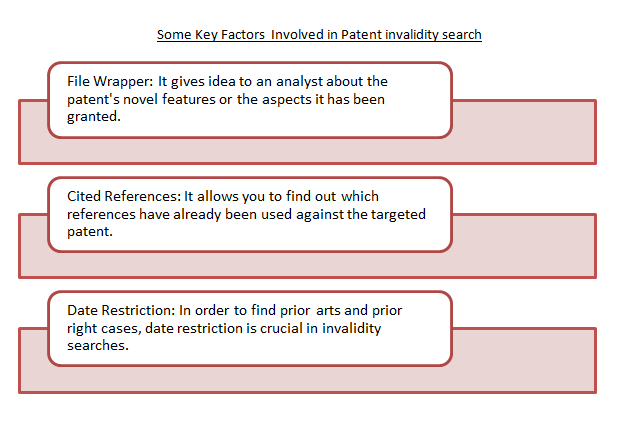Patent Invalidity Search : The last line of defense
A patent invalidity search is a prior art search that is done to invalidate one or more claims of a competitor’s patent after a patent is issued. It is usually one of the steps that is taken by a company whenever it is faced with a patent infringement lawsuit. The purpose of an invalidity search is to find prior art that was probably overlooked by a patent examiner so as to challenge the validity and declare the claim(s) invalid.
Table of Contents
Factors involved in an Patent invalidity search
An Invalidity search is different from a normal prior art search due to some important factors involved in the search that are mentioned below:

- File Wrapper:
File wrapper of a targeted patent includes all conversations between the examiner and the applicant. Reading a file wrapper gives an idea to an analyst about the aspects on which the patent has been granted or the novel feature of the patent. This gives an idea to an analyst that which part of the claim has not been identified by the examiner and finding the same should be his priority.
Further, File wrapper also gives an idea of what search strategy examiner adopted, like keywords and classifications, etc. and accordingly the analyst can define directions of the search to find the references for invalidating the claim(s).
- Cited References:
All documents (patent or non-patent literature) that are already cited for the targeted patent are known as cited references. The details regarding cited references are dug out from the File Wrapper. Analysis of the cited references helps the analyst to find out which references have already been used against the targeted patent. The analyst gets a clear picture of the missing part to invalidate the targeted claim(s) of the patent.
- Date Restriction:
Date restriction plays a major role in an invalidity search to find out prior arts and prior right cases.
Prior art cases are those that are published before the priority date of the patent to be invalidated. Prior right cases are those cases that are published after the priority date of the targeted patent but their priority date is before the priority date of the targeted patent.
Prior right cases are used with various restrictions like in some cases, the jurisdictions of the found prior right reference must be same as that of the patent to be invalidated. Prior right case must be claiming same features as claimed by the targeted invention.
Silver Bullet Search
Silver Bullet Search is a variant of Invalidity Search, just like other search variants such as SV1, SV2, SV3 and SV4.
| Version | Jurisdictions | Language |
| SV1 (Quick) | Patent Search in 100+ Countries (25+ Countries Full Texts) Add on: Non-Patent Literature (NPL) Search | English |
| SV2 (Adequate) | Patent Search in US, EP, WO, DE, FR, GB, CN, KR & JP (Full Texts) Add on: Non-Patent Literature (NPL) Search | English |
| SV3 (Comprehensive) | Patent Search in 100+ Countries (25+ Countries Full Texts) (X-Y hours) Add on: Non-Patent Literature (NPL) Search | English + German + French |
| SV4 (Comprehensive +) | Patent Search in 100+ Countries (25+ Countries Full Texts) (X-Y hours) Add on: Non-Patent Literature (NPL) Search | English + German + French + Japanese + Chinese + Korean |
Silver Bullet Search is one of the search variants of Invalidity Searches. Invalidity searches are done with the objective of invalidating or revoking an existing patent claim. This search is typically done upon confrontation with a patent infringement suit.
Silver Bullet Search is taken as a challenge to put in best efforts to invalidate a claim. Usually when clients want a deep exploration to invalidate a claim, silver bullet search is used. The pricing varies in this type of search and the primary advantage for the client is the condition to pay total service fee only if the relevant prior art is obtained. If not, a nominal fee is charged. Silver Bullet Searches cover searches for patent and non-patent literature as well as industrial designs. Let us know about it in detail:
How Silver Bullet acts as an effective last hope:
- Independent claims – Silver Bullet divides the claim into two parts, thereby allowing independent claims. The two parts are divided into: Novelty destroying prior arts (complete claim in a single document) and Inventive step destroying prior arts/documents.
- No limit to Jurisdictions – There is no limit to the number of jurisdictions performed in silver bullet searches.
- Database – Silver Bullet searches are conducted on multiple databases such as Questel Orbit, Derwent Innovation, PatSeer, etc. Silver bullet Plus uses national databases for searches like Kipris (Korean patent database), Sino (Chinese patent database), Jplatpat (Japanese patent database). These searches are done in multiple languages. Basic searching is also done on Google Patents, Espacenet, WIPO, Google search for normal patents. Besides these patent databases, search is also conducted in several non-patent databases as mentioned below:
Lens.org, Springer, Science direct, Google Scholar, Research Gate, etc.
- Language – The languages used for these searches varies for Silver Bullet (SB) and Silver Bullet Plus (SB+):
SB – 3 languages – English, German, French
SB+ – 6 languages – English, German, French Korean, Japanese and Chinese language search (Analysis is done on machine translated English version)
- Hours – The focus is primarily on results so that no stone is left unturned. Therefore, flexible deadlines are provided to benefit client’s interest. Focus is more on results than on billable hours as it is about getting results using a comprehensive search with unlimited iterations.
- Reward – A monetary benefit to analyst on success is guaranteed which automatically motivates him to deliver the best.
Case Study
When the stakes are high or the case is on prosecution or litigation stage, clients often choose Silver Bullet Search. Let us look at a case study on a silver bullet search that was conducted by Sagacious IP for a leading home appliances company in Europe.
The client was recommended to contact Sagacious IP by his colleague who had previously got a couple of landscape searches done and was pleased with the services. The client’s initial email revealed that while they had identified some prior art, they were of the opinion that it was not very promising. Nonetheless, they were going to use it for initial opposition proceedings while they wanted Sagacious IP to dig deep and find something worthwhile.
While the interim results were not enough to destroy novelty, Sagacious IP interacted with the internal team of lawyers at client site to review the findings. Upon follow up meetings, the client was able to understand the results derived and how they proved to be relevant for his defense. He was pleased with the results and shared the following feedback:
“Thank you for your additional feedback on the comments from our side. In the meantime, we had some further internal discussion based your feedback. As a result, we think the search revealed two historic patents which we consider relevant in context of the specific competitor IP. If needed, we could start legal actions with the aim to achieve nullification of the competitor IP – in order to achieve an acceptable negotiation result.”
Final Thoughts
When you need to dig prior art to help your case, Silver Bullet Searches can prove to be a guaranteed solution. Whether you are a patent agent, patent attorney at a law firm or a corporation, you can benefit from Silver Bullet Search service. For more details on this service, click here.
-Lakshay Sharma (Engineering) and the Editorial Team




